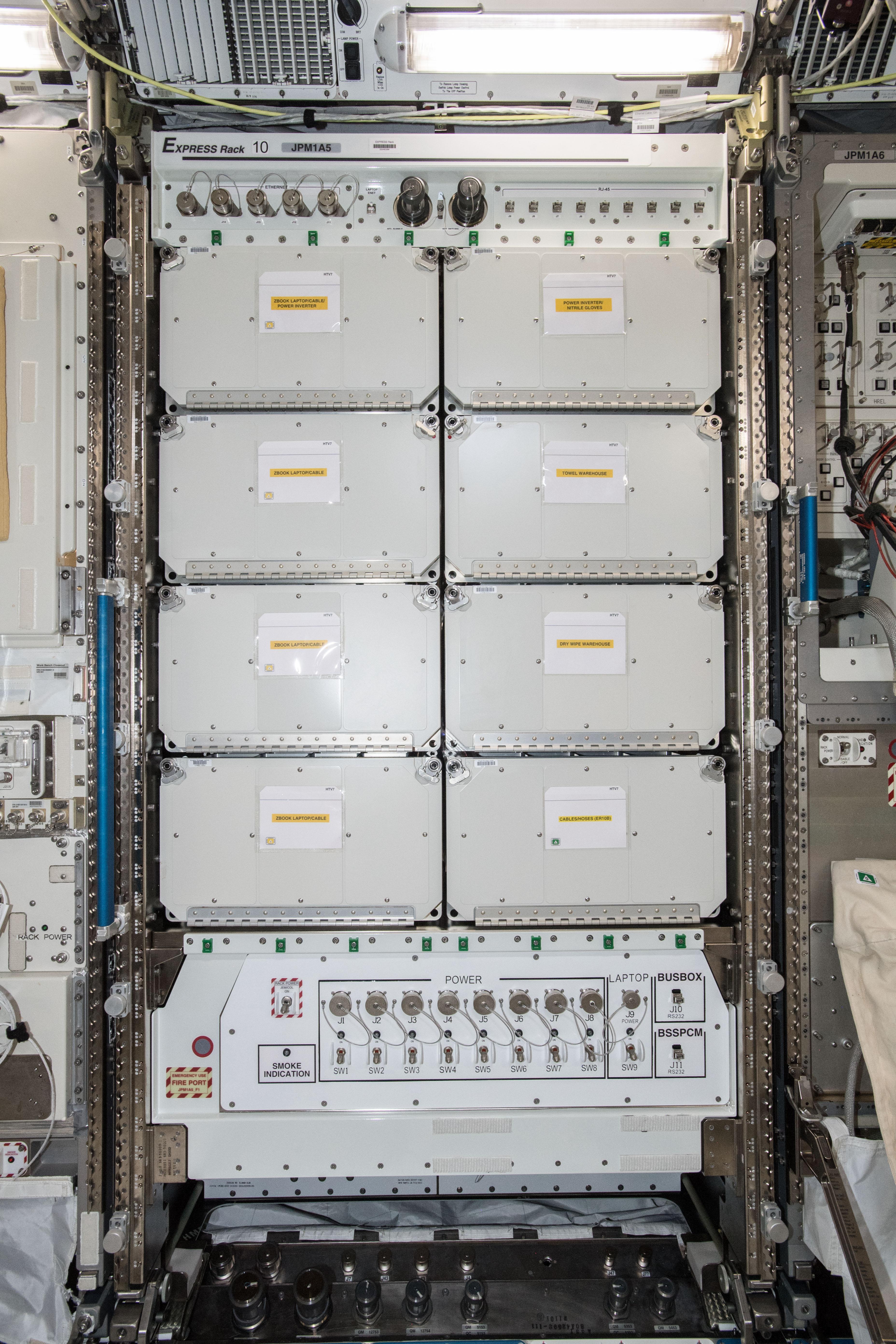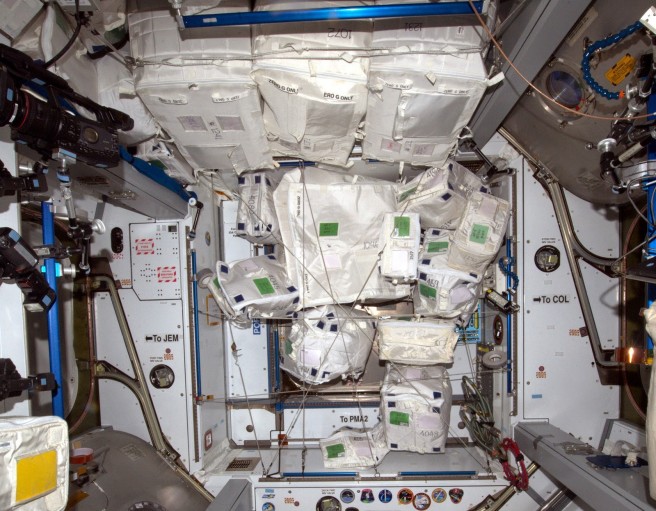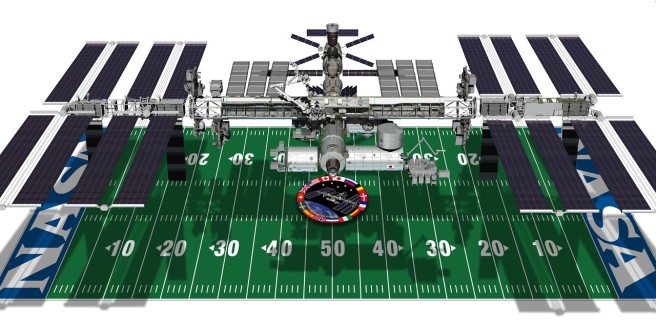On May 23rd, 2018, I had an idea. I was having dinner with a friend. That night, the International Space Station (ISS) was going to pass almost directly overhead just after sunset; the perfect conditions under which to view it. What’s more, a Cygnus resupply spacecraft had recently launched, and had approached the station close enough to be seen next to it as a separate, dimmer point of light. For whatever reason, over dinner the thought occurred to me; what if we built a replica of the ISS, so that we could explore it? We could wander around inside, taking all the twists and turns, looking inside all the different cabinets and storage areas. We could poke around at the scientific apparatuses, see how the hatches worked, crawl inside the attached capsules, look down into the cupola. Then we could go outside and see the massive solar panels, the robotic Canadarm, and explore the equipment on the huge truss that holds it all together. It would be amazing! Who wouldn’t love that?
My friend was immediately skeptical. Isn’t the ISS huge? Wasn’t it insanely expensive to build?
To these challenges, my mind automatically generated solutions using the strategies I had absorbed from being a software developer; so-called “agile” or “lean” methodologies. (I’ll use lowercase here, since I’m not referring to their official definitions, but instead to the general principles that have spread throughout the profession via habit and hearsay.) In agile development there’s a term called MVP, which stands for Minimum Viable Product. If your future is highly uncertain, with limited funding and a small team, then instead of starting to build the best product you can think of in its mature form, consider the minimum-effort version of the product that still provides the fundamental functionality. If you get that far, start showing it to people right away, so that you can incorporate their feedback as soon as possible. Sometimes the feedback will be things you expected because you know it’s the minimal version: maybe people will complain that it doesn’t have many features, or that it looks ugly. But sometimes reality will surprise you, and people won’t care about how it looks, and instead they’ll all want a slightly different version of the product than what you were thinking of. Since you haven’t invested a lot of resources into a specific design, it’s easier to make iterative improvements.

So I asked myself, what is the minimum viable version of this ISS replica? We could get a bunch of plywood, nail it together in the shape of the internal corridors of the ISS, get images of all of the panels, print them on life-sized posters, and hang up the posters on the plywood. This would get you a sense of the size and structure of the whole station for, what, a few hundred bucks?
My friend was not impressed.
Okay, okay, I said, that’s not thrilling, but hear me out. That was literally my first thought. We could trivially improve this. We could go to a junkyard and get a lot of the stuff that’s inside the station — ethernet cables, cameras, Thinkpads — and velcro it all over the walls and ceiling. We could go to the Container Store and buy lots of those fabric bags that astronauts use to store things, remove one of the plywood panels, and fill the gap with a bunch of the “zero-g stowage”. We could replace some of the panels with tablets, and write interactive apps about the station. I proposed that through a series of similar modifications, we could create a pretty cool playground environment, and still not spend more than a couple thousand.


We talked about a lot more tangential ideas (“Would NASA give us funding?”, “We could take it to Burning man!“), and eventually the conversation moved on.
Later that night, we got up on the roof, ready with binoculars. The ISS appeared on the horizon, and we tracked it as it approached the zenith. Eventually it shot overhead, bright as I’ve ever seen it. We did our best at hand tracking it with the binoculars, but for whatever reason, we weren’t able to find the trailing Cygnus capsule.
The Real MVP
Since then, I’ve done a lot more thinking and research, and I’ve entirely changed my idea of what the MVP should be. Though the plywood & posters version would be fun to walk through, it would be better to have something that could more plausibly generate self-sustaining revenue. And while you can go fairly far with upgrading the plywood & posters, it’s hard to see a smooth transition between that and a realistic replica of the entire station, inside and out; at some point you just have to scrap the whole thing and start over.
I also clarified my goals, by introspecting on what got me so excited about the idea;
1. provide a realistic, immersive experience of the station
2. use it as a platform for STEM education via physically interactive exhibits.
My eventual vision was the station as a science museum. Instead of just being a playground, the internals would all be designed as exhibits that taught you things about how the ISS worked, the environment of space, and the science experiments that are continuously performed inside the station. From my cursory research, it seems like museums typically get built all at once; some rich person or organization decides they want a museum, and that’s that. I could attempt to petition rich people, but this is not a particularly hopeful strategy. Instead, I decided to start with an MVP, something I knew I could build on my own, and something which, if my idea is good and I adapt to the lessons I learn, will naturally lead me to the next stage. My eventual MVP plan arose from discovering the station’s greatest engineering strength; a double-layer of modularity.
Modularity from the outside
The ISS is about the size of a football field. But all this really means is that it’s about as long and as wide. It is dramatically smaller in volume than, for example, a warehouse the size of a football field. If you fold up all those solar panels, detach the truss, and lay all the pieces next to each other, I reckon they could all fit inside the 15 yard line. How did this gangly structure get into space in the first place? The ISS was taken into orbit almost entirely by NASA’s fleet of space shuttles. Because the space shuttle payload bay is only so big, the ISS had to be designed as many separately functional modules, and then built, launched and assembled together one at a time.
How did this gangly structure get into space in the first place? The ISS was taken into orbit almost entirely by NASA’s fleet of space shuttles. Because the space shuttle payload bay is only so big, the ISS had to be designed as many separately functional modules, and then built, launched and assembled together one at a time.

Given this, instead of making a replica of the “whole” station out of shoddy materials, the new idea for an MVP is to build only one module, and make it look fairly realistic from the inside and outside. It still has the property of being an immersive, interactive science exhibit. People will be able to approach a big cool space-looking thing, walk inside of it, and play with dozens of science exhibits. It’s the kind of thing that could travel around to museums, schools or conventions. It’s a relatively practical goal to aim for, and if I get to this checkpoint then I’ll have a better shot at getting more resources to continue, and I’ll have more experience to know how to best move forward. The amount of revenue it can generate roughly scales with its size, providing a sustainable path forward.

Modularity from the inside
Great, so now I have a much more attainable goal, and I didn’t have to give up any of the vision. Now the big question is, which module do I build first? After a long series of reasoning that I’ll detail in a later post, I decided on the module that is officially known as Destiny, but which the astronauts called the US Laboratory, or just “the lab”.
Destiny, along with most of the other pressurized modules, has a very simple architecture. It is a tube whose cross-section is a circle on the outside and a square on the inside. The square provides the equivalent of a floor, ceiling, and two walls. This gives four separate volumes of equal size and shape, one for each side of the square. Finally, the tube is sliced up lengthwise in slices of equal width. These volumes end up being the size of a large wardrobe, and are filled by what is called an International Standard Payload Rack (ISPR). They hold science equipment, electronics, life support, and even the astronaut bunks.

Thus, all of the internals of these pressurized modules can be regarded in terms of the modular ISPRs. They are the same across all the relevant modules, no matter the orientation or country of origin, and can be physically removed and swapped around by the astronauts on board. This is fantastically useful for the real ISS, and is fortunately very useful for my project as well.
I wouldn’t really want to build a big cylindrical shell of a space module and then have nothing in it; that is not an MVP. On the other hand, if I have a bunch of ISPRs full of awesome science exhibits, those might be marketable even without a space module for them to go in. This also scales down nicely, all the way down to one rack.

Now we have arrived at the third and most practical level of the plan. We design and build a single rack, housing self-contained interactive science exhibits about the ISS. This has relatively little upfront investment, both in terms of money and time. In the process I’ll learn a lot about my ability to build things and design exhibits. One rack is a sensible object to offer museums as a rentable exhibit, or to schools as part of a science curriculum. Along the way I’ll gain information about what resources I have in my social network. I’ll have a physical artifact that can give people an experiential sense of what the museum will eventually look like. Best of all, it works directly toward the final vision; the ISPR that I build might be able to slot right into the full ISS replica, which is more than we could say about plywood & posters.
I kept this idea in the back of my mind for several months, doing incremental research here and there. Then I spent a couple weekends building an ISPR frame. Eventually, I left my job, and a few months later, I decided to go full time on this idea. If you’d like to follow along, subscribe to this blog. And if you have any questions or advice, go ahead and contact me, either here or on twitter.

